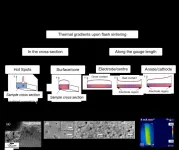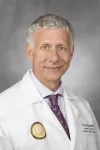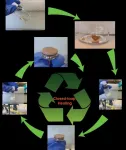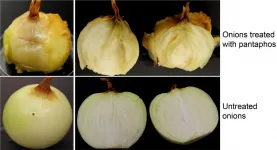Breaking the warp barrier for faster-than-light travel
Astrophysicist at Göttingen University discovers new theoretical hyper-fast soliton solutions
2021-03-09
(Press-News.org) If travel to distant stars within an individual's lifetime is going to be possible, a means of faster-than-light propulsion will have to be found. To date, even recent research about superluminal (faster-than-light) transport based on Einstein's theory of general relativity would require vast amounts of hypothetical particles and states of matter that have "exotic" physical properties such as negative energy density. This type of matter either cannot currently be found or cannot be manufactured in viable quantities. In contrast, new research carried out at the University of Göttingen gets around this problem by constructing a new class of hyper-fast 'solitons' using sources with only positive energies that can enable travel at any speed. This reignites debate about the possibility of faster-than-light travel based on conventional physics. The research is published in the journal Classical and Quantum Gravity.
The author of the paper, Dr Erik Lentz, analysed existing research and discovered gaps in previous 'warp drive' studies. Lentz noticed that there existed yet-to-be explored configurations of space-time curvature organized into 'solitons' that have the potential to solve the puzzle while being physically viable. A soliton - in this context also informally referred to as a 'warp bubble' - is a compact wave that maintains its shape and moves at constant velocity. Lentz derived the Einstein equations for unexplored soliton configurations (where the space-time metric's shift vector components obey a hyperbolic relation), finding that the altered space-time geometries could be formed in a way that worked even with conventional energy sources. In essence, the new method uses the very structure of space and time arranged in a soliton to provide a solution to faster-than-light travel, which - unlike other research - would only need sources with positive energy densities. No "exotic" negative energy densities needed.
If sufficient energy could be generated, the equations used in this research would allow space travel to Proxima Centauri, our nearest star, and back to Earth in years instead of decades or millennia. That means an individual could travel there and back within their lifetime. In comparison, the current rocket technology would take more than 50,000 years for a one-way journey. In addition, the solitons (warp bubbles) were configured to contain a region with minimal tidal forces such that the passing of time inside the soliton matches the time outside: an ideal environment for a spacecraft. This means there would not be the complications of the so-called "twin paradox" whereby one twin travelling near the speed of light would age much more slowly than the other twin who stayed on Earth: in fact, according to the recent equations both twins would be the same age when reunited.
"This work has moved the problem of faster-than-light travel one step away from theoretical research in fundamental physics and closer to engineering. The next step is to figure out how to bring down the astronomical amount of energy needed to within the range of today's technologies, such as a large modern nuclear fission power plant. Then we can talk about building the first prototypes," says Lentz.
Currently, the amount of energy required for this new type of space propulsion drive is still immense. Lentz explains, "The energy required for this drive travelling at light speed encompassing a spacecraft of 100 meters in radius is on the order of hundreds of times of the mass of the planet Jupiter. The energy savings would need to be drastic, of approximately 30 orders of magnitude to be in range of modern nuclear fission reactors." He goes on to say: "Fortunately, several energy-saving mechanisms have been proposed in earlier research that can potentially lower the energy required by nearly 60 orders of magnitude." Lentz is currently in the early-stages of determining if these methods can be modified, or if new mechanisms are needed to bring the energy required down to what is currently possible.
INFORMATION:
Original publication: Erik W Lentz, Breaking the Warp Barrier: Hyper-Fast Solitons in Einstein-Maxwell-Plasma Theory, Classical and Quantum Gravity, March 2021. DOI: 10.1088/1361-6382/abe692
Contact:
Dr Erik Lentz
Email: lentze.phd@gmail.com
Tel (US number): (00) +1 540 352 6280
https://www.eriklentzphd.com/
[Attachments] See images for this press release:
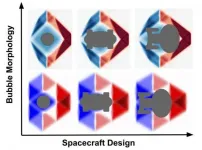
ELSE PRESS RELEASES FROM THIS DATE:
2021-03-09
Researchers have demonstrated that a slimy, yet tough, type of biofilm that certain bacteria make for protection and to help them move around can also be used to separate water and oil. The material may be useful for applications such as cleaning contaminated waters.
In the journal Langmuir, North Carolina State University researchers reported the findings of an experiment in which they used a material produced by the bacteria Gluconacetobacter hansenii as a filter to separate water from an oil mixture.
"It's really remarkable to think that these little bugs can make this stuff that is so perfect in many ways," said Lucian Lucia, the study's corresponding author and an associate professor of forest biomaterials and chemistry at NC State.
The biofilm the bacteria make and ...
2021-03-09
Flash sintering is a ceramic processing technique which uses electric current to intensively heat the ceramic sample internally rather than using only external furnace heating. The process can lower ceramic processing temperatures and durations significantly, enabling ceramics to be co-processed with metals or other materials, and reducing energy use.
However, the process can result in low quality ceramics due to weaknesses caused by inhomogeneities in the microstructure.
The origins of these inhomogeneities caused by thermal gradients in the material during flash sintering have been studied by researchers ...
2021-03-09
Deforestation may cause an initial increase in malaria infections across Southeast Asia before leading to later decreases, a study published today in eLife suggests.
The results may help malaria control programs in the region develop better strategies for eliminating malaria infections and educating residents on how to protect themselves from infection.
Mosquitos spread the malaria parasite to humans causing infections that can be severe and sometimes deadly. In the area along the Mekong river in Southeast Asia, many residents hunt or harvest wood in the surrounding forests, which can increase their risk of infection. Yet recent outbreaks of malaria in the region have also been linked to deforestation.
"As countries in the region focus their malaria control ...
2021-03-09
As the fight against COVID-19 continues, scientists have turned to an unlikely source for a potentially effective treatment: tiny antibodies naturally generated by llamas.
While the world has welcomed the news of multiple vaccines against COVID-19, the search for effective treatments for those who contract the virus is ongoing. Now scientists are looking to what might seem to be an unlikely source: the South American llama.
Researchers are using the ultrabright X-rays of the Advanced Photon Source (APS), a U.S. Department of Energy (DOE) Office of Science User Facility at DOE's Argonne National Laboratory, to help turn naturally generated llama antibodies into potentially effective therapies against ...
2021-03-09
Every 12 minutes, someone in the United States dies of pancreatic cancer, which is often diagnosed late, spreads rapidly and has a five-year survival rate at approximately 10 percent. Treatment may involve radiation, surgery and chemotherapy, though often the cancer becomes resistant to drugs.
Researchers at University of California San Diego School of Medicine and Moores Cancer Center, in collaboration with Sanford-Burnham-Prebys Medical Discovery Institute and Columbia University, demonstrated that a new tumor-penetrating therapy, tested in animal models, may enhance the effects of chemotherapy, reduce metastasis ...
2021-03-09
Computational models of air quality have long been used to shed light on pollution control efforts in the United States and Europe, but the tools have not found widespread adoption in Latin America. New work from North Carolina State University and Universidad de La Salle demonstrates how these models can be adapted to offer practical insights into air quality challenges in the Americas outside the U.S.
Computational air quality models can be used in multiple ways. For example, they can be used to determine which sources are responsible for what fraction of air pollution. They can also help authorities predict how air pollution might change if different pollution control methods are adopted.
"Historically, it's been very challenging to apply these modeling ...
2021-03-09
Polymer scientists from the University of Groningen and NHL Stenden University of Applied Sciences, both in the Netherlands, have developed a polymer membrane from biobased malic acid. It is a superamphiphilic vitrimer epoxy resin membrane that can be used to separate water and oil. This membrane is fully recyclable. When the pores are blocked by foulants, it can be depolymerized, cleaned and subsequently pressed into a new membrane. A paper describing the creation of this membrane was published in the journal Advanced Materials on 7 March 2021.
How do you clean up an oil spill in ...
2021-03-09
Study Reveals New Hope for Men With Common Urinary Issues
A new systematic review of evidence recommends the use of behavioral self-management treatments for common urinary issues experienced by upwards of 70 percent of older men. Common symptoms include trouble urinating, increased frequency and incontinence. These symptoms can have a substantial negative impact on sleep, social functioning and quality of life. Several guidelines recommend self-management techniques like health education, advice on fluid intake, and bladder retraining; however, in practice, self-management is often excluded from the menu of treatment options that include medication and surgery.
Researchers at Bond University's Institute for Evidence-Based Healthcare found that ...
2021-03-09
What would a truly progressive city look like? A city that pays more than lip service to issues that directly affect low-income residents, seniors, marginalized communities and others whom neoliberal policies have seemingly left behind? ...
2021-03-09
Since 1983, the bacteria Pantoea ananatis has been known to infect several important crops including onions, rice, and corn. It was unclear, however, what molecules were involved. A new study, published in mBio, has identified one of the culprits: pantaphos. Intriguingly, the researchers have discovered that pantaphos can also act as an herbicide and it is toxic to glioblastoma cells, making it an exciting candidate for agricultural and biomedical applications.
"Herbicide resistant weeds are an issue in agriculture," said William Metcalf (MMG leader), a professor of microbiology. "Unfortunately, there hasn't been a new class of herbicide ...
LAST 30 PRESS RELEASES:
[Press-News.org] Breaking the warp barrier for faster-than-light travel
Astrophysicist at Göttingen University discovers new theoretical hyper-fast soliton solutions

